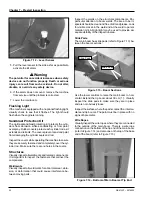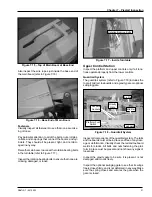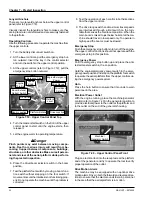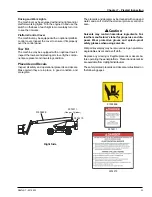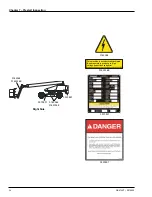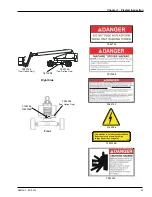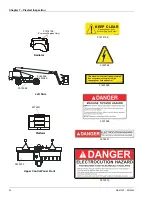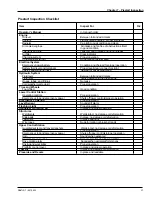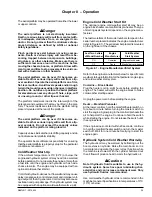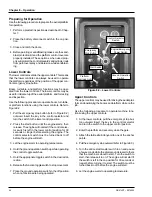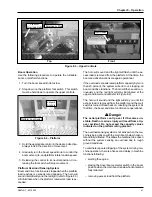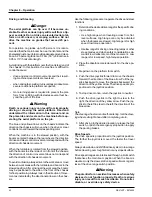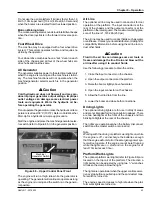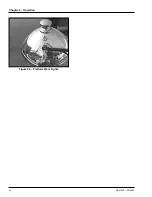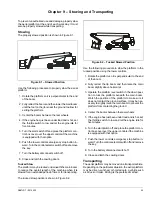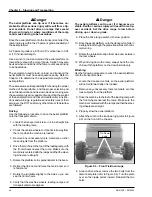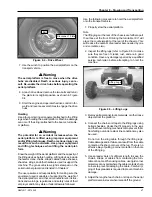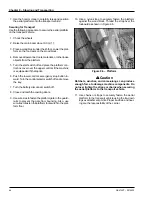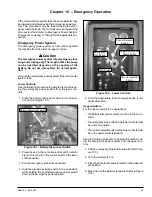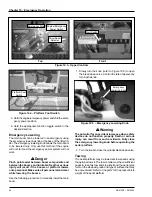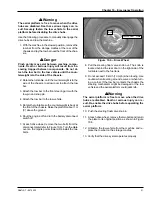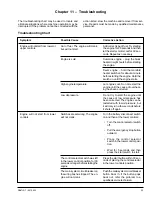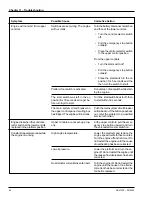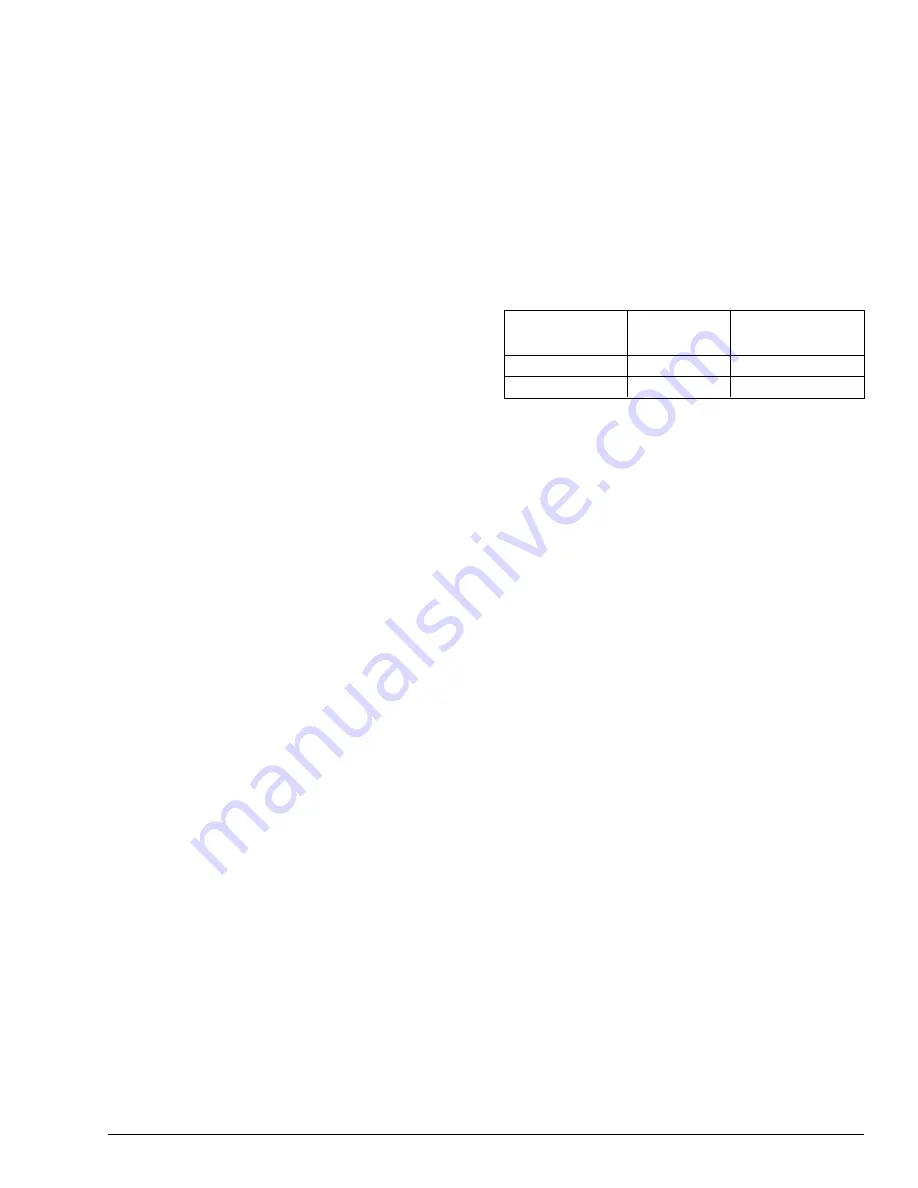
SB47JRT – 0075522
39
Chapter 8 – Operation
The aerial platform may be operated from either the lower
or upper controls.
A
Danger
The aerial platform is not electrically insulated.
Death or serious injury will result from contact with,
or inadequate clearance from, an energized con-
ductor. Do not go closer than the minimum safe ap-
proach distance as defined by ANSI or national
safety regulations.
Pinch points may exist between moving compo-
nents. Death or serious injury will result from be-
coming trapped between components, buildings,
structures, or other obstacles. Make sure there is
sufficient clearance around the machine before
moving the chassis, booms, or platform. Allow suffi-
cient room and time to stop movement to avoid con-
tact with structures or other hazards.
The aerial platform can tip over if it becomes un-
stable. Death or serious injury will result from a tip-
over accident. Operate the aerial platform on a firm,
flat, level surface. Avoid travel speeds and/or rough
terrain that could cause sudden changes in platform
position. Do not drive or position the aerial platform
for elevated use near any drop-off, hole, slope, soft
or uneven ground, or other tip-over hazard.
The platform rated work load is the total weight of the
personnel and equipment that may be lifted in the plat-
form. The work loads are stated on the platform rating
placard mounted at the rear of the platform.
A
Danger
The aerial platform can tip over if it becomes un-
stable. Death or serious injury will result from a tip-
over accident. Do not exceed the capacity values
indicated on the platform rating placard.
Capacity values indicate the rated lifting capacity and do
not indicate aerial platform stability.
The operator bears ultimate responsibility for ensuring
that the aerial platform is properly set up for the particular
conditions encountered.
Cold Weather Start-Up
If the ambient temperature is 0°C (32°F) or below, the
engine and hydraulic system oil may need to be warmed
before operation. Do not operate the engine at more than
a fast idle until the engine and hydraulic oil has had a
chance to warm. The engine may be equipped with an
optional cold weather start kit.
Cold, thick hydraulic oil does not flow well and may cause
delay in response to control movement and improper volt-
age output of the AC generator. Cold oil may also cause
cavitation and pump damage. The hydraulic system may
be equipped with an optional cold weather warm-up kit.
Engine Cold Weather Start Kit
The optional engine cold weather start kit may be an
engine block heater or a manifold air pre-heater. The type
of starting assist system depends on the engine manu-
facturer.
The last two letters of the model number stamped on the
serial number placard indicates the engine manufacturer
(refer to Figure 8.1). The serial number placard is mounted
on the right rear of the chassis.
Figure 8.1 – Engine Manufacturer/Start System
Refer to the engine manufacturer below for specific cold
weather start-up information for that particular engine type
and cold weather start system.
Cummins — Block Heater
Plug the heater cord in eight hours before starting the
engine. The heater will warm the engine block to make
cold weather starting easier.
Unplug the power cord before starting the engine.
Deutz — Manifold Preheater
At the lower controls, hold the manifold heater switch on
for about a minute before turning the master switch to
start the engine. A glow plug in the manifold preheats the
air to help start the engine. Continue to hold the switch
while starting the engine. Do not release the switch until
the engine starts.
If the engine does not start within 20 seconds, continue
to hold the manifold heater switch and turn the master
switch off. Wait for one minute before trying to start the
engine again.
Hydraulic System Cold Weather Warm-Up
The hydraulic oil may be warmed by bottoming out the
boom extension cylinder. Raise the main boom so it is
horizontal and operate the boom retract function while
the machine is stowed. With the cylinder bottomed out
the oil flow will produce heat to warm the hydraulic oil.
A
Caution
Not all hydraulic fluid is suitable to use in the hy-
draulic system. Some have poor lubricating char-
acteristics and can increase component wear. Only
use hydraulic fluid as recommended.
Use cold weather hydraulic oil as recommended in the
machine General Specifications in temperatures of 0°C
(10°F) or below.
Last Two Letters
of Model Number
Engine
Manufacturer
Cold Weather
Start System
DZ
Deutz
Manifold air pre-heater
CU
Cummins
Engine block heater
Summary of Contents for SB47JRT
Page 1: ...SB47JRT Operator Manual Jan 08 PN 508361 000 SB47JRT ...
Page 2: ......
Page 6: ......
Page 13: ...Chapter 2 Specifications SB47JRT 0075522 7 Engine Oil Viscosity Cummins B3 3 Deutz F3L 2011F ...
Page 14: ...Chapter 2 Specifications 8 SB47JRT 0075522 ...
Page 30: ...Chapter 6 Controls 24 SB47JRT 0075522 ...
Page 44: ...Chapter 7 Prestart Inspection 38 SB47JRT 0075522 ...
Page 50: ...Chapter 8 Operation 44 SB47JRT 0075522 Figure 8 6 Platform Work Lights ...
Page 58: ...Chapter 10 Emergency Operation 52 SB47JRT 0075522 ...
Page 64: ...Chapter 11 Troubleshooting 58 SB47JRT 0075522 ...
Page 66: ...Appendix A Glossary SB47JRT 0075522 ...
Page 67: ......






